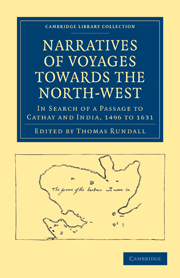 Narratives of Voyages Towards the North-West, in Search of a Passage to Cathay and India, 1496 to 1631
Narratives of Voyages Towards the North-West, in Search of a Passage to Cathay and India, 1496 to 1631 Published online by Cambridge University Press: 05 October 2010
Before entering on the narratives of the voyages undertaken for the discovery of the North-west passage, some observations will be offered on two points connected with the general subject of North-polar researches, viz.: i. The claims of Sir Hugh Willoughby to be considered a discoverer; and, ii. The probability of an Englishman, named William Adams, having made a voyage to Spitsbergen, a.d. 1595.
Of the Claims of Sir Hugh Willoughby to be considered a Discoverer
By injudicious advocacy on one hand, and by careless oversight, or wilful neglect, on the other hand, the reputation of Sir Hugh Willoughby is at present left to the mercy of conjecture. One authority has laboured to prove him to be entitled to the merit of a particular discovery. Another authority peremptorily denies the validity of the grounds on which the claim is made on his behalf. Neither takes any pains to ascertain whether he is entitled to distinction for any other service than the one particularized.
It is Purchas who claims the merit of a particular discovery for Sir Hugh Willoughby. Purchas states, that in his progress towards the North-east, the navigator was driven to the height of 72°, where he fell in with an island which is designated Willoughby Land, lying in a particular direction, and at a specified distance from a place named Seynam. “From thence”, it is said, he proceeded in a certain direction, saw certain lands, and finally cast anchor in a certain locality: which is described, and to which the following remark is applied; “And this is the land which is now colled Greenland, or King James his New Land, and is known to the Hollanders by the name of Spitzbergen”.
To save this book to your Kindle, first ensure [email protected] is added to your Approved Personal Document E-mail List under your Personal Document Settings on the Manage Your Content and Devices page of your Amazon account. Then enter the ‘name’ part of your Kindle email address below. Find out more about saving to your Kindle.
Note you can select to save to either the @free.kindle.com or @kindle.com variations. ‘@free.kindle.com’ emails are free but can only be saved to your device when it is connected to wi-fi. ‘@kindle.com’ emails can be delivered even when you are not connected to wi-fi, but note that service fees apply.
Find out more about the Kindle Personal Document Service.
To save content items to your account, please confirm that you agree to abide by our usage policies. If this is the first time you use this feature, you will be asked to authorise Cambridge Core to connect with your account. Find out more about saving content to Dropbox.
To save content items to your account, please confirm that you agree to abide by our usage policies. If this is the first time you use this feature, you will be asked to authorise Cambridge Core to connect with your account. Find out more about saving content to Google Drive.